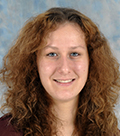

A Design for Manufacture approach for electrospun scaffolds.
PhD Supervisor(s): Felicity Rose; Cameron Alexander; Melissa Mather; Joel Segal.

Electrospinning is a widely used technique to generate thin scaffolds of a fibrous nature that mimic the extracellular matrix (ECM). It is a relatively straightforward and versatile method and a whole variety of synthetic and natural polymers can be electrospun. It is well known that fibre structure and alignment influences mammalian cell bahaviour including differentiation. More recent electrospinning related research has included gaining control over fibre alignment and deposition, and inclusion of mammalian cells during the electrospinning process. At Nottingham we have recently been working on the incorporation of nanosensors within the electrospun fibres to monitor the culture microenvironment,combining thermoresponsive polymers for switching cell adhesion/detachment and using formers to introduce bundled fibre alignment into electrospun scaffolds which can further influence cell behaviour.
Recently published work indicates that stem cells can be cultured on polymer surfaces with thermo-switchable adhesion. Preliminary data extending this study indicatess that new reactive initiators can be used to coat a range of substrates, enabling the preparation of variable adhesion surfaces.
Alongside these scaffold material/manufacturing developments there is a need for a non-invasive, label-free, three-dimensional imaging of 3D constructs using techniques that provide both temporal and spatial information, deliver rapid results, and are applicable to a clinical environment. Furthermore, parameters such as cell viability, cell number and distribution in the delivery agent as well as the integrity of the biomaterial have been identified as key criteria.
Optical imaging techniques have the potential to meet these needs; however, many optical approaches are not suitable for imaging constructs that are not-transparent and turbid. In this project an optical technique to improve the spatial resolution and information content attainable from 3D imaging of constructs will be used. This technique is a label free analogue to selective plane illumination fluorescent microscopy. Compared to other optical methods for 3D imaging e.g. OCT label-free Single PLane Illumination Microscopy (SPIM) the method proposed here has several potential advantages, the imaging can be much faster as imaging is performed at a single wavelength.